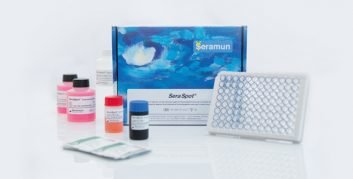R-Biopharm offers you a new product line: SeraSpot®, the new microspot array for multiplex diagnostics of autoimmune diseases.
In autoimmunity, the immune system attacks structures of its own body. Depending on the attacked structure (e.g. nerves, joints, liver), the symptoms and thus the kind of disease vary. Today, around 81 different autoimmune diseases are known. These can be either localized, i.e. organ-specific, or systemic autoimmune diseases.
Many autoimmune diseases are characterized by autoantibodies. The autoantibodies are either directly pathogenic (e.g. anti-GBM) or disease associated. They can be valuable as prognostic markers (e.g. anti-AMA-M2), helpful in patient monitoring (e.g. anti-dsDNA) or necessary for differential diagnosis (e.g. anti-Mi2). Importantly, the earlier the diagnosis of AID is made the better is the outcome of the patient. This is especially important in progressive e.g. rheumatic, fibrotic diseases that lead to irreversible deficits.
Diagnostics for autoimmune diseases
Autoantibody testing is a central element in the diagnosis and treatment of AID. R-Biopharm offers SeraSpot®, a new microspot array for the diagnosis of autoimmune and infectious diseases. Today, the SeraSpot® platform comprises 4 different microspot arrays plus the microspot array scanner for the diagnosis of connective tissue disease, autoimmune liver disease or systemic vasculitis and goodpasture disease.
Connective tissue diseases are systemic inflammatory rheumatic diseases usually characterized by a chronic course (systemic connective tissue diseases) with often overlapping symptoms (overlap syndromes). Connective tissue diseases include the following diseases and patients are typically screened for anti-nuclear antibodies (ANA):
- Systemic lupus erythematosus (SLE) and subsets
- Sjögren’s syndrome (SjS)
- Systemic sclerosis (SS)
- Idiopathic (autoimmune) myositis
- Mixed connective tissue disease (MCTD or sharp syndrome)
- Overlap syndromes.
Primary autoimmune liver disease (AL) can be subdivided into:
- Autoimmune hepatitis (AIH) type I to III
- Primary biliary cirrhosis (PBC)
- Primary sclerosing cholangitis (PSC)
- Overlap disease with characteristics of AIH and PBC or PSC.
Clinical symptoms of AL are similar to other chronic liver diseases and may progress into liver cirrhosis. Only an early diagnosis and treatment may prevent such an outcome. About 15 % of chronic liver disease cases underlie an autoimmune pathogenesis. Therefore, the determination of different autoantibodies is useful.
Laboratory findings in autoimmune hepatitis include seropositive results for antinuclear antibodies (ANAs), smooth-muscle antibodies (F-Actin), or liver-kidney microsomal type 1 (LKM-1) or anti–liver cytosol 1 (anti-LC1) antibodies. The diagnostically relevant antibodies for AIH are used for the sub-classification of AIH as well as the differentiation from PBC.
Primary systemic vasculitis of small and middle large vessels of unknown ethiopathogenesis is associated with anti-neutrophil cytoplasmic antibodies (ANCA). The three types of vasculitis associated with ANCA are:
- Granulomatosis with polyangiitis (Wegener’s) (GPA)
- Microscopic polyangiitis (MPA)
- Eosinophilic granulomatosis with polyangiitis (Churg-Strauss syndrome) (EGPA).
More than 90 % of GPA and MPA patients are ANCA positive. In most European studies, the ANCA antigen specificity of MPA is predominantly myeloperoxidase (MPO) and for GPA is predominantly proteinase 3 (PR3). EGPA patients are ANCA positive in 50 % of cases, mostly MPO. MPO-ANCA associated vasculitis is more common in Japanese and Chinese, while PR3-ANCA is more common in Europeans. Glomerulonephritis is more common and more severe In PR3-ANCA associated vasculitis compared to patients with MPO-associated vasculitis.
Goodpasture disease is a glomerulonephritis, with or without pulmonary hemorrhage, characterized by circulating anti–glomerular basement membrane (anti-GBM) antibodies. Early recognition and treatment of this syndrome are critical for the prognosis of renal function. Sometimes the goodpasture syndrome can be superimposed to ANCA positive systemic vasculitis. On top of the anti-GBM antibodies implicated in the disease, about one in three of those affected are also ANCA positive. ANCA positivity often predates the anti-GBM antibodies by about a few months or even years.
Choose an indication
Choose a technology
Choose your autoimmunity product
You might also be interested in
Autoimmunity support
Questions? Tap into our team’s expertise. We’re here to support you and your business throughout the testing process to ensure your success








